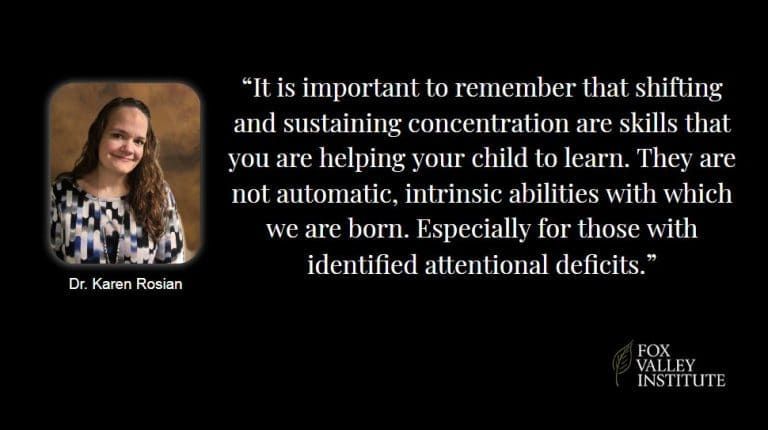
At first thought, many consider distractibility and hyperactivity as the defining characteristics of Attention Deficit Hyperactivity Disorder. Demonstrating difficulties in sustaining concentration, being prone to anger and frustration, difficulty sitting still, significant disruptive behavior in most settings due to impulsivity, are the common hallmark symptoms of ADHD. However, there are other, less disruptive symptoms that are often overlooked or attributed to other motives.
An additional, less commonly talked about characteristic, is a difficulty in shifting attention as needed. This is often referred to as hyper-focus. Hyper-focus is demonstrated when a child (or adult) can become so focused on an activity that they are unable to shift attention appropriately as necessary, to another task, person, etc. This is most often seen when a child becomes engrossed for hours on end with a specific activity, such as Legos, reading, or a video game. This is not where it typically interferes with day to day life. In fact, depending on the activity, it can be seen as beneficial (i.e. most parents don’t complain about a child reading too much!).
When working with parents, a common concern/complaint expressed is when they feel their child is ignoring their requests. This is a common trait in many children. When I hear this from a parent, my first thought is to try to determine if there is a level of hyper-focus in action. Is the child “ignoring” their parent, or, is the child just engrossed in an activity to the detriment of being able to shift their attention when their parent is making a request? However, to be clear, this singular trait, in and of itself, does not solely indicate the presence of attention deficit hyperactivity disorder in a child.
It is important to first get more information about the context of the situation(s).
- Where is the child relative to the parent?
- Are they in the same room?
- What is the distance?
- Is the child engaged in a task or is the child demonstrating that they are giving the parent their full attention when the request is made (i.e. making eye contact, responding to the prompt verbally)?
Why ask these questions? They provide information to determine if there is an attentional issue at play, or if there is a behavioral issue to be addressed.
Where is the child relative to the parent? Are they in the same room? What is the distance?
Often times, parents or caregivers will make requests of a child from a separate room. The child will be in the living room or their bedroom and the parent will call from another room for the child to complete a task. For example, telling the child to take the garbage out. Ten minutes later, the parent is frustrated, if not angry, that the child has not completed the task. They make the request once more typically receiving an errant “I’m coming” from the child. Again, the garbage remains in the home rather than disposed of in the garbage bin. This cycle replays until the parent reaches peak frustration and enters the room enraged.
Is the child engaged in a task? Are they demonstrating that they are giving their full attention?
Children, particularly those with attention-deficit hyperactivity disorder, will fully immerse themselves in a task, to the exclusion of most other stimuli. Let’s say the task is an enjoyable one. The child is fully immersed in an activity such as watching a favorite television program or playing the latest video game (Fortnite anyone?). The child will unconsciously “tune out” intrusions into their attentional field, including their parent’s requests. A parent will be talking to their child and the response varies from no response, an automatic response to the prompt (i.e. “Yeah yeah, I’m coming”) or the tell-tale headshake– you know the one where they finally turn to you and pretend to pay attention?
So, the question is- What can you do? You are a parent who is desperately trying to teach your child responsibility by having them take the garbage out. There is hope! You have a few options:
- Always make a request to the child from within the same room.
- This is not always ideal, though it serves a purpose. When a parent is in the same room as the child, they are able to see whether the child is immersed in a task. They can determine if or how the child is responding non-verbally to their presence and the request.
- When the parent enters the room, does the child notice?
- When the parent speaks, does the child look up in the direction of the parent?
- Do they make eye contact with you while you are talking?
- If the answer is “no” there is a chance that they are fully immersed in their activity. And yes, there is still also a chance that they are, in fact, ignoring you. But let’s test it out.
- Walk up to the child so that you can provide additional input/stimulation.
- When you speak, pair it with another source of input/stimulation.
- When you are talking, place your hand on their shoulder or arm to gather their attention.
- Sometimes it can be helpful to break their line of vision if they are engrossed in a video game or television program. This will prompt the child to look in the direction of the intrusion- you.
- Behaviorally speaking, this should help enable the child to, over time, once successfully paired, to attend to a verbal command without the presence of the tactile or visual input.
2. Make sure that you have their sustained attention.
- Before making your request, make sure that the child has their face directed towards you, and more so, that they are making eye contact. There are so many times that a child will turn their head but maintain eye contact with the brightly colored screen that has so aptly captured their attention.
- If necessary, prompt them to look at you, or a personal favorite, particularly for young children, tell them to look here and point to the tip of your nose.
- Once you have their sustained attention, make your request.
- If it appears that they are not paying attention, and even if they are, ask them to repeat the directions. Children have amazing acting skills when it comes to looking as though they are paying attention, when, in fact, they are not. It provides an opportunity to ensure that they have taken the important information.
- If it is a multi-step task, such as “take out the garbage and then make sure to feed the cat and clean the litter box.” have the child repeat the list. This will help to ensure that they have successfully listened and will also help (though not guarantee) them remember the tasks.
- For the child that does have some difficulty with memory, retaining information, or for a child that is particularly prone to distraction, it may be necessary to take additional steps.
- Make requests one at a time.
- Provide the child with an additional aid, such as a list of the tasks for them to refer to as they complete each step.
- Stay in the area to redirect them if they become distracted. If the child should become distracted, repeat the same procedure to get them back on task. Ensure that you have their attention and redirect them back to the task at hand.
It is important to try to remember that this is a skill that you are helping them to learn. It is not an automatic, intrinsic ability with which we are born. Especially for those with identified attentional deficits. As with any skill, it will take time, patience, and perseverance, both on the part of the child, and on the part of you, the parent or caregiver. If this does not work, it may be necessary to speak with someone to help troubleshoot the procedure, explore additional options, and/or to address additional behavioral problems.
Additional Resources:
https://fvinstitute.com/attention-deficits-living-with-add-and-adhd
https://fvinstitute.com/a-regular-checkup-is-good-for-the-mind-as-well-as-the-body/
https://fvinstitute.com/are-selfies-a-sign-of-a-mental-disorder/
https://fvinstitute.com/dependent-personality-disorder-diagnosis-and-treatment/
https://fvinstitute.com/highly-sensitive-people-strengths/



